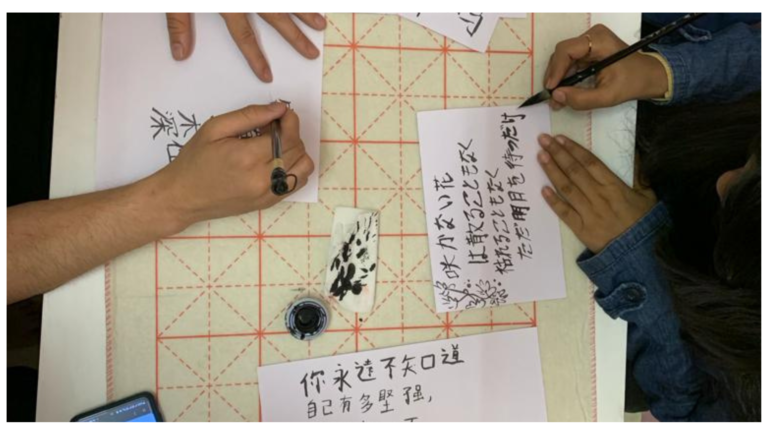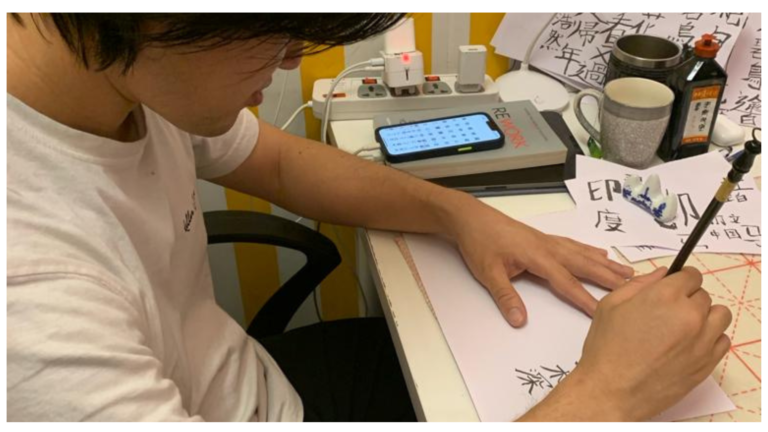Japanese
March 25, 2022 2024-06-07 7:57Japanese


Japanese Language Courses in Vashi Navi Mumbai
ようこそ!

Why learn Japanese with us?
Learnlanguages.store offers group Japanese Language classes for adults in all levels, from total beginner to advanced conversation. Taught by professional native Japanese teachers, these classes are a great way to meet fellow Japanese learners and build your Japanese language skills. Our focus on conversational Japanese will have you using and practicing the language from your very first lesson. Our Japanese group classes meet twice a week for 120 minutes and are offline at our Vashi Navi Mumbai branch. You can also learn Online on our iOS, Android or website this allows you to join one of our popular groups from anywhere in the world. Our private lessons may be just the program for you. These lessons are tailored to your or your small group’s specific goals and schedules, allowing you to learn Japanese at the speed and level that suits you best. Private lessons are also ideal for learners with very targeted needs, such as applying for work in Japan, focusing on kanji, or preparing for the JLPT or other specialized exams
Learn The Essential Skills
Earn Certificates And Degrees
Get Ready for The Next Career
Master at Different Areas
Japanese courses taught by the world's Best Japanese teachers
Best Moments

























You aren't in this alone

Top Rated class
We are a top-rated language school teaching Japanese in Vashi Navi Mumbai Mumabi and nationwide. Group and private lessons, adults and kids, schools, corporate, or film -no matter your level, we can help you achieve you Japanese language goals.

Amazing learning Environment
A perfect environment that helps you learn more effectively compared to traditional classroom methods.

Online and offline learning
Learn on our IOS or Android mobile app or on our website. It has most advance language learning tools.

Courses from professionals around the globe.
Get teamed up with the specialists who work and teach languages for years at famous universities.

Flexible Scheduling
We offer flexible scheduling for both groups and private lessons, allowing you to start your Japanese classes at any time and at your convenience. You can have them online or offline. We want to help you learn Japanese in a fun, engaging, and encouraging environment.

Intensive Learning
Our lessons are tailored to your specific goals and schedules, allowing you to learn Japanese at the speed and level that suits you. These are Best for targeted needs, such as applying for work , business Japanese , or graduate school entrance exams
Transform your career
After finishing your language course, get your certificate from the Learn Languages Store. It will not only advance your career, but it will also improve your CV.

Frequently Asked Questions About Japanese Courses

Why learn Japanese?
Here are 10 great reasons to learn Japanese
1. Japan has the 2nd largest economy in the world.
Japan is a prosperous country and has the most diverse economy in Asia. With a GDP of $4.9 trillion in 2005, Japan’s economy is 2nd only to that of the U.S. The leading Japanese companies are among the largest, most efficiently run, and most well-known firms in the world. Familiar names like Sony, Toshiba, Sanyo, Casio, Canon, Minolta, Honda, Toyota, Mitsubishi, and many others have infiltrated the world market in a variety of sectors.
Whether you’re in the field of business, engineering, manufacturing, research, economics, or politics, chances are you will be competing with, if not working for, a Japanese entity.
2. Knowing Japanese brings business opportunities.
Japanese consumers spend 100s of billions of dollars each year on consumer goods and services like food, clothing, travel, and entertainment. The typical household has over $100,000 in savings and a disposable monthly income of $3,800. With all of that cash to spend, it is perhaps not surprising then that the United States exports more goods and services to Japan than any other overseas destination. In 2004, exports to Japan accounted for $54 billion of the U.S. GDP. In addition to these exports, 1000s of U.S. companies have successful branches in Japan. In 2004 alone, U.S. businesses spent $78 billion in direct investment in Japan.
Being able to communicate with potential customers in their own language is key to winning their business. In addition, when you learn Japanese, you become not only proficient in the language but also gain an insider view of the culture. Understanding the Japanese work ethic, their business etiquette, and knowing which cultural faux pas to avoid can often make or break an important business deal.
3. Japanese is a gateway to other Asian languages & cultures.
Throughout its history, Japan has been shaped by the influence of Asia’s great civilizations: India, China, and Korea. While the cultures of these Asian countries do differ, Asian cultures together share many similarities that differentiate them from Western ways and norms. So a study of Japanese can open your perspective on the values that other Asian nations share with Japan, including religious beliefs, ethics, and aesthetics. A familiarity with Asian cultures also allows you to step outside the culture you live in and see it from a fresh, new perspective.
4. Japanese-speakers are the Internet’s 3rd largest language group.
The Japanese make up the third largest language community on the Internet, after only English and Chinese speakers. An estimated 88 million Japanese, or 9.6% of the world’s online population, are connected to the Internet. Knowing Japanese can connect you to these people in an instant. They may just be future friends or acquaintances, business associates, or even the market that you or your future employer hopes to target.
5. The Japanese are innovators.
Considering that Japan is geographically isolated island nation that is densely populated and poor in natural resources makes the strength of the Japanese economy seem even more impressive. The Japanese have relied on their creativity and scientific know-how to succeed not only economically but also in ecology- and efficiency oriented. ways. The Japanese are known as high tech leaders in fields such as optical media, semiconductor manufacturing, industrial robotics, and fermentation processes. Their drive for innovation has made the Japanese the world leaders in patent filings at 420,000 applications annually.
6. Japanese cultural exports are exploding.
From anime to sushi bars, karaoke to manga, bonsai to origami, Japanese culture has become part of international culture. A knowledge of the language will give you direct access to Japanese film, animations, and comic books, give you insight into the special terminology used in your favorite martial art, help you understand the cultural basis for kamikaze training and the origin of the samurai warrior, and develop your ability to order sashimi like a native at your favorite Japanese restaurant!
7. Knowing Japanese will set you apart from the crowd.
The majority of people who learn a foreign language choose a European language like Spanish, French, German, or Italian. Choosing a less commonly learned language will pop out on your resume and differentiate you from the crowd.
8. The Japanese are international tourists.
With all of the disposable cash in their pockets, 16.8 million Japanese tourists headed to destinations abroad in 2004. In a survey, 94% of Japanese visitors to the U.S. reported shopping during their stay, and more so than any other group, the Japanese were more likely to pay for goods and services in cash. 3.7 million Japanese tourists visited the US in 2004, second only to the British among overseas tourists. Visitors from Japan spent $12.4 billion in the U.S. in 2004, up 24% from the previous year, and were alone responsible for the majority of the U.S. travel trade surplus.
The market for Japanese tourist dollars is strong. A knowledge of Japanese can gain you entry into that market. Of course, knowing Japanese will make your own visit Japan both easier and much more enjoyable.
9. It’s not as hard as you think!
It’s true that Japanese has a much different system of writing than English or any other European language. However, foreigners can get by with learning the 44 or so hiragana or katakana characters that represent sounds in much the same way as the English alphabet does.
In addition, the grammar of Japanese is in many ways simpler than that of European languages. Japanese nouns have no genders, plural forms, or accompanying articles to learn. The language also has only two verb tenses, present and past, and includes very few irregular verbs. Spoken Japanese has only 5 vowel sounds and spelling is phonetically consistent, making the language relatively easy to pronounce.
10. Japanese is a stepping stone to learning other Asian languages.
Like other languages of Southeast Asia, Japanese is a highly analytical language, relying heavily on function words rather than extensive systems of inflection to denote linguistic properties. These languages also share a similar subject-predicate sentence structure. Though Southeast Asian languages are distinctly different among themselves, as a group they are clearly differentiable from geographically more distant language families, such as Indo-European and Afro-Asiatic languages.
In particular, the grammar of Japanese is very similar to that of Korean and both languages have an equally advanced system of honorific for showing respect. And Japanese takes its kanji writing system from the Chinese system of ideographs. Learning Japanese brings you a step closer to taking on Korean or Chinese because many of the concepts underlying the language are similar.
What are the most challenging aspects in Japanese?
1. The Writing System
The Japanese writing system is incredibly complex. It took me a while just for me to wrap my head around how the writing system works, let alone actually use it. It’s not just one writing system like in English, but three: hiragana, katakana, and kanji. Hiragana is used for Japanese words, katakana is used for foreign, scientific, or emphasized words, and kanji, the more complicated Chinese characters, are used very often. In everyday usage, all three different writing systems are mixed up and used together. So you will find hiragana, katakana, and kanji all used together in the same sentence.
Hiragana and katakana are easy enough. They are phonetic syllabaries, where each character, or kana, represents a sound. Unlike the English alphabet, where it’s one sound per letter, a kana can represent a combination of sounds. For example, か (ka) is just one character, where in English it is two different letters (k-a). The good thing about hiragana and katakana is that they’re completely phonetic, so there are no silent letters or tricky consonant combinations, like in English. The kana are also fairly simple shapes.
Kanji is where it gets really confusing. Kanji characters came to Japan from China, sometime around 500 AD, when Japan didn’t yet have it’s own writing system. The system stuck, and the characters have been adapted in to usage in modern Japanese. A kanji represents both a sound and a meaning. For example, 中 represents both the sound “na,” and the meaning of “middle,” or “during.” Some kanji are incredibly intricate. Take, for example 護 (mamoru), meaning “protection,” which written with 20 different strokes. The most strokes you need to write an English letter is two.
There’s no definitive count of the total number of kanji in existence, but there are a lot. Some estimates are as high as 5,000, but it’s safe to say that about 2,000-3,000 kanji are commonly used in Japanese. So, to be fully literate, you need to know at least 2,000 different characters! That’s crazy! Compare that to English, where it will only ever be different combinations of the same 26 letters. You learn to read in kindergarten, and you’re set. In Japan, students continue learning new kanji into high school, college and adulthood. So, suffice it to say, I’m not expecting to ever master, or even really begin to grasp kanji. I’ve heard it takes at least 9 years of serious studying to become literate in Japanese.
2. Context
Japanese is a very high context language, and coming from English, a very low context language, this can be quite tricky. High context means that certain information is left out of sentences, because it is assumed that both the speaker and the listener already understand this information from the context of the situation. For example, it is very common to drop subjects in Japanese. So instead of saying, “I go to Tokyo,” like you would in English, you would just say, “go to Tokyo,” leaving out the subject, “I”. If Tokyo has previously been mentioned, you might just say, “go to,” and, “I go to Tokyo” is meant to be understood. But for those of us just starting to learn Japanese, it’s not always so easy to understand the context. This makes it difficult to follow conversations and comprehend the meaning of what’s being said, and unsaid.
3. Counting Words
In English you say “one, two, three…” for everything you count. One glass of water, three soccer balls, five stories on a building, ten pencils. Easy, right? It’s not so simple in Japanese. Counting words are exceptionally complicated in Japanese. First, you’ve got your regular numbers: “ichi, ni, san…” Then you’ve got your “general” counting words: “hitotsu, futatsu, mitsu…” Then you’ve got a bunch of different sets of counting words, depending on what you’re counting. So, you have to use different words if you’re counting drinks versus floors on a building, versus minutes, versus paper and flat things, versus sticks/long items.
I want to know who in Japan’s history was so bored that they decided to come up with this system. Why do we need a whole different set of words to count flat things versus stick-shaped things? It’s almost comical to me. The good news is, you can get by using regular numbers and general counter words for everything. People will still understand what you mean.
4. Speed
Every language sounds like it’s being spoken fast to non-speakers. But when you hear Japanese people speaking back and forth in rapid fire, the speed – it’s just so fast! It has to be faster than I speak, right? Turns out, it’s not just my perception; Japanese really is spoken faster than other languages.
Université de Lyon did a study comparing the speeds of various languages, using syllables per second as the measure. Of the eight languages surveyed, Japanese was the fastest, clocking in with an average speed of 7.84 syllables per second. English, on the other hand, was spoken at the rate of 6.19 syllables per second. And Chinese measured only 5.18 syllables per second. So, yes, Japanese actually is spoken faster than English speakers are used to.
Interestingly, Japanese had the fastest syllabic rate, but the slowest information density. What does that mean? It means that to get your point across in Japanese, you have to say a lot more words than you would in English. And to get in all those extra words, you say it a lot faster!
5. Fewer Possible Sound Combinations
Japanese has fewer possible sound combinations than English, because certain sounds (such as “L”) don’t exist in Japanese. The total number of possible single-syllable sounds in Japanese is around 100. The number of possible single-syllable sound combinations in English, on the other hand, is somewhere upwards of 10,000. That’s a huge difference!
This is actually good news for learning to speak. Because there are fewer possible sounds, they are all fairly easy to pronounce. It may struggle with putting them all together, but it’s easy to say the individual sounds of Japanese. It’s not, however, easy to listen and distinguish these sounds from each other when used in words. Many words in Japanese sound very similar, and it’s hard for non-native speakers to tell them apart. For example, the word for “no” isいいえ (iie), and the word for house is いえ(ie). The only difference in pronunciation is the long versus short “i” sound, which to me sounds basically identical. English has words like this too, but there are a lot more in Japanese, since there are fewer possible sounds in the first place.
How many people speak Japanese?
There are nearby 120 million (12CR) Japanese speakers in Japan. It was surveyed that there are (70 Lakh) 7 million Japanese speakers that spread in different countries such as:
- United States of America
- United Kingdom
- Brazil
- Philippines
- People’s Republic of China
- Canada
- Singapore
- Australia
- Mexico
- Taiwan
- South Korea.
Is Japanese a great career move?
As you learn to speak Japanese, you’re going to see your career grow exponentially! Here are some of the biggest benefits of learning Japanese for your professional life.
1. Translation
This may come as no surprise, but if you’re proficient in Japanese, you’ll be able to use your language skills to work in translation. This is especially useful if you want to to earn a supplemental income.
Plus, you will be in high demand in the U.S. if you can speak Japanese. Census shows that there were 436,110 Japanese speakers in the U.S. in 2011. This number is small compared with other languages like Chinese (2,882,497) and Spanish (37,579,787).
If you want to get a job as a translator, however, get ready to buckle down and study hard. A translation job will usually require you to have an advanced knowledge of Japanese.
In translation, you will be working on all types of assignments from business and academic, to legal documents. The more technical the document, the more difficult it is to translate.
According to SimplyHired, the average pay for a Japanese translator is $43,000. If you would like to earn an income on the higher end, look into becoming a paralegal, as the average salary for a Japanese bilingual paralegal is $51,000.
Keep in mind that these figures can be deceiving, as part-time and temporary positions are more abundant than full-time positions.
Besides more income, translation jobs are generally flexible and convenient. The jobs are often project based, and you can work from home and around your schedule. This has been a lifesaver for me, and I’ve also met great a mentor through a translation job.
2. Work in Japan
Despite the flexibility translation jobs offer, not everyone is looking to earn a supplemental income. You may already have a full-time career, or you may be looking to start one.
If that’s the case, you may want to consider working in Japan. Although this is a big decision and lifestyle change, it’s a great opportunity for you to build your career while living in Japan.
Besides, landing a career in Japan is easier than you think!
Robert Walters, an international recruiting firm, reports that there is a shortage of bilingual professionals. According to their report, there were 1.09 job offers for every candidate in 2014.
Bilingual professionals are in high demand in jobs in human resources, engineering, and sales, so if you speak Japanese and have technical skills, you have a good chance of landing a job in Japan.
Working in Japan also makes economical sense, as wages for bilingual professionals have been increasing at an average of 10 percent each year as the Japanese economy continues to recover.
3. Get Connected
While learning Japanese can expand your professional options, the real purpose of language is to connect with others.
Jerry Weintraub, a legendary talent manager and movie producer, says that the connections you have with others largely defines your life. Through his ability to make connections, he booked concerts for Elvis Presley and Frank Sinatra in their prime years.
Most of us may not have the people skills and ability to negotiate like Mr. Weintraub, but knowing Japanese, even a little, can help you connect with new people. This could lead you to a new job, a new business opportunity, or even a great friendship!
4. Challenge Yourself
Learning Japanese is not easy. If you want to challenge yourself, picking up this difficult language is one of the best ways to do so.
Challenging yourself in one area (even if totally unrelated to your job or other aspects of your personal life) will undoubtedly improve your tenacity, self-confidence, and abilities in other areas as well.
5. Improve Your Workplace Status
Most managers will admire a person who challenges themselves with constant personal growth – if you want to improve your status at work, learning Japanese is one of the best ways to do so.
Whether you just know business Japanese or even a few basic greetings, picking up the language is a great way to get other clients and business partners (particularly those from Japan) to respect you.
What is JLPT?
The Japanese Language Proficiency Test, or JLPT, is a standardised Japanese language test offered to non-natives of the Japanese language. The test is the same for all test takers, regardless of their native tongue. It aims to test a broad range of knowledge, from reading and listening, to language knowledge.
As the test is standardised, many employers see it as an easy way to get a general understanding of a potential non-native hire’s language abilities. While the test arguably has its flaws, it certainly takes a large amount of skill in the language to pass, so it can be a reliable filter for employers to use. Gaining certification will only increase your chances of finding employment in Japan, so if that is your goal it is worth the effort.
How many levels are there in Japanese?
At Learnlanguages.store we have 5 levels in Japanese.
- Basic ( JLPT N5 )
- Elementary ( JLPT N4 )
- Intermediate (JLPT N3)
- Advanced ( JLPT N2 )
- Proficiency ( JLPT N1)
These courses are designed as per JLPT (JAPANESE LANGUAGE PROFICIENCY TEST)
The JLPT has five levels: N1, N2, N3, N4 and N5. The easiest level is N5 and the most difficult level is N1.

N4 and N5 measure the level of understanding of basic Japanese mainly learned in class.
N1and N2 measure the level of understanding of Japanese used in a broad range of scenes in actual everyday life.
How long do the JLPT preparation courses last?
Our courses last from 4 weeks upwards and you can tailor them to fit in a number of hours to suit you. Not everyone can spend a month or longer studying in Japan so we also offer an online and offline course in Navi Mumbai.
What are the key differences of JLPT levels?
LEVEL – N5 (PROFICIENCY – BASIC)
One is able to understand familiar expressions and phrases. If spoken slowly, one can follow simple conversations.
LEVEL – N4 (PROFICIENCY – ELEMENTARY)
One is able to read, understand and follow familiar topics concerning daily life situations. One understands basic Japanese.
LEVEL – N3 (PROFICIENCY – INTERMEDIATE)
One can understand specific contents regarding everyday situations by grasping the difficult writings or conversations to some extent.
LEVEL – N2 (PROFICIENCY – UPPER-INTERMEDIATE)
One is able to understand and communicate extensively everyday situations. Also, they can follow the essential points of certain topics.
LEVEL – N1 (PROFICIENCY – ADVANCED)
One is able to understand complex writings on a variety of topics. They can follow and understand conversations coherently

See What Our Students Have To Say
just learnt french and my experience was amazing
January 22, 2022
Great app, very easy to use
September 1, 2022
Best Japanese language classes in Mumbai and Navi Mumbai.
January 22, 2022












